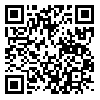BibTeX | RIS | EndNote | Medlars | ProCite | Reference Manager | RefWorks
Send citation to:
URL: http://jsaeh.khu.ac.ir/article-1-2621-en.html
Urmia Lake is one of the largest hyper saline lakes in the world and largest inland lake in Iran which located in the north west of Iran, between the provinces of East Azerbaijan and West Azerbaijan. The lake basin is one of the most influential and valuable aquatic ecosystems in the country and registered as UNESCO Biosphere Reserve. In addition, it is very important in terms of water resources, environmental and economic. Unfortunately, lake water level has dramatically decreased in recent years, due to various reasons. This issue has created some problems for Local people, especially people living in rural area in east of the Lake. The results of this research are of great importance for regional authorities and decision-makers in strategic planning for people of inhabits in east coast village.
The present paper is an attempt to integrate a semi-automated Object-Based Image Analysis (OBIA) classification framework and a CA-Markov model to show impacts of Urmia Lake Retrogression On eastern coastal villages. OBIA present novel methods for image processing by means of integration remote sensing and GIS. Process and outcome of this methodology can be divided in three step including: Segmentation, Classification and Accuracy assessment.in the process of segmentation aims to create of homogeneous objects by considering shape, texture and spectral information. A necessary prerequisite for object oriented image processing is successful image segmentation. In our research the segmentation step was performed by applying multi-resolution segmentation and considering 0.2 for shape and 0.4 for the compactness. The scale of segmentation is also an important option which leads to determine the relative size of each object. Having great values for scale leads to create large objects while smaller value would result small objects respectively. In this study the scale parameter of 100 has been selected based on the size of objects in Scale of study area as well as spatial resolution of the satellite images were used for segmentation. In doing so, we employed spectral and visual parameters contains: texture, shape, color tone and etc. for developing object based rule-sets. To determine the characteristics of the spectral data and geometric features classes the fuzzy based classification was performed by employing fuzzy operators including: or (max) operator with the maximum value of the return of the fuzzy, the arithmetic mean value of fuzzy and the geometric mean value of fuzzy, and (min). After this step, the validation process was performed by using overall accuracy and Kappa coefficient. Then, using the CA-Markov Model The trend of changes was predicted in the future (For 2020). Another way to predict changes in land use and cover, used the CA-Markov model. Markov chain analysis is a useful tool for modeling land use changes. Markov chain model consists of three step: First step Calculating the probability conversion using Markov chain analysis, second step, Calculating the Cover and land use maps competently on the basis of multi-criteria evaluation, third step, assign locations cover and land use simulation based on the CA position operator.
Results of Satellite image processing indicate that the area of garden, Farmland, Zones of muddy-salty (Saline soils), moist salt and newly formed salt have increased while area of Urmia lake has rapidly dropped between 1984 and 2015. The area of Urmia lake declined from 4904.51 square kilometers in 1984 to 676.79 square kilometers in 2015. The farmland area increased from 177.72 square kilometers in 1984 to 542.37 square kilometers in 2015. The garden area increased from 83.71 square kilometers in 1984 to 227.28 square kilometers in 2015. The moist salt area increased from 111.89 square kilometers in 1984 to 945 square kilometers in 2015. Zones of muddy-salty (Saline soils) area increased from 859.01 square kilometers in 1984 to 2986.5 square kilometers in 2015. The newly formed salt increased from 171.27 square kilometers in 1984 to 921.99 square kilometers in 2015. Markov chain model results indicate in 2020 the garden area will be 638 square kilometers, the moist salt area will be 717 square kilometers, Zones of muddy-salty (Saline soils) area will be 4127 square kilometers, the farmland area will be 644 square kilometers, the newly formed salt area will be 363 square kilometers and the Urmia lake area will be 118 square kilometers.
Received: 2017/02/8 | Accepted: 2017/02/8 | Published: 2017/02/8
| Rights and permissions | |
 | This work is licensed under a Creative Commons Attribution-NonCommercial 4.0 International License. |






